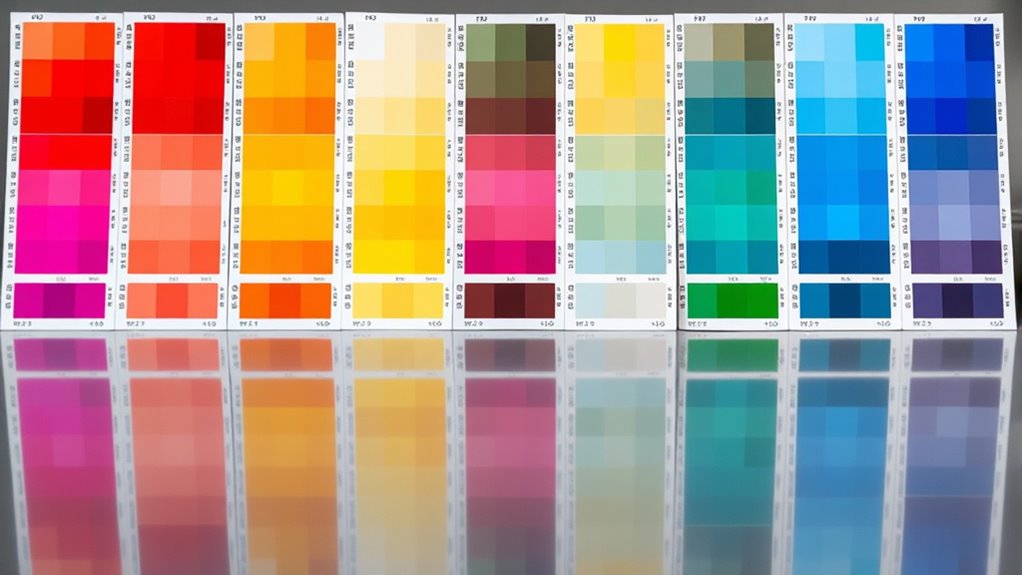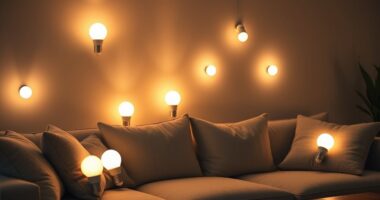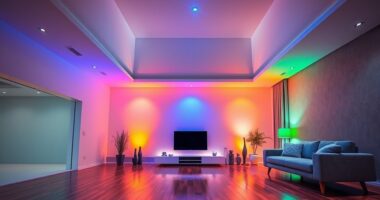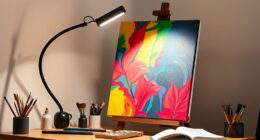If you’re looking to perfect your color accuracy, I recommend exploring the top 12 photography color checker charts, including options like the Calibrite ColorChecker Passport Photo 2, Datacolor SpyderCHECKR, and professional gray balance cards. These tools help guarantee consistent, true-to-life colors across different lighting conditions and devices, essential for professional results. Keep going to discover which chart best fits your workflow and how they can elevate your photography quality.
Key Takeaways
- High-quality color checker charts feature durable materials, standardized swatches, and comprehensive gray scales for precise color calibration.
- Compatibility with popular software like Adobe Lightroom, Photoshop, and ICC profiles ensures seamless workflow integration.
- Suitable for professional photographers, videographers, and colorists needing reliable calibration in studio or on-location shoots.
- Portable, lightweight designs with protective features enable easy use across diverse environments and shooting conditions.
- Selection criteria include color accuracy, material durability, device compatibility, and overall value for professional calibration needs.
Pixel Perfect Camera Colour Correction Card (Set of 2)
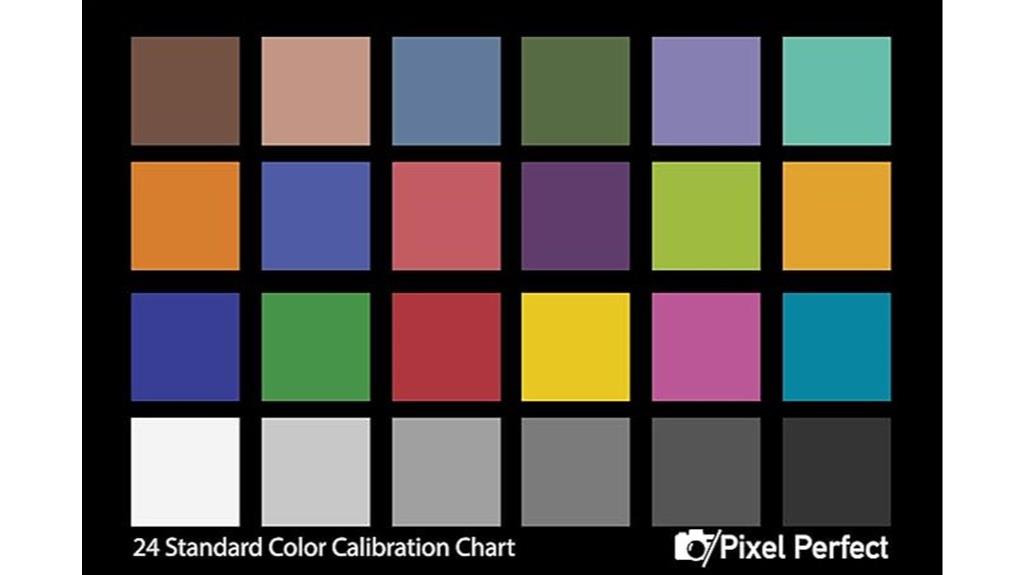
If you’re serious about achieving accurate color reproduction in your photos and videos, the Pixel Perfect Camera Colour Correction Card (Set of 2) is an essential tool. I use it to guarantee consistent white balance, exposure, and color accuracy across different lighting conditions. Its standardized color swatches and neutral gray patches make calibration straightforward, even for beginners. Made from durable synthetic paper with a matte finish, it prevents glare and lasts through tough shoots. The included software allows precise adjustments, helping me maintain professional results. Compact and lightweight, it fits easily in my gear bag, making on-the-go calibration simple and reliable.
Best For: photographers and videographers seeking accurate color calibration and white balance in diverse lighting conditions for professional-quality results.
Pros:
- Provides standardized color swatches and neutral gray patches for consistent calibration
- Made from durable synthetic paper with matte finish to prevent glare and withstand tough shoots
- Compact, lightweight design allows for easy portability and on-the-go use
Cons:
- Slightly higher price point compared to basic calibration charts
- Requires compatible software and some technical understanding for optimal use
- Limited to color calibration, not a comprehensive lighting or exposure tool
Calibrite ColorChecker Passport Photo 2 (CCPP2)

The Calibrite ColorChecker Passport Photo 2 (CCPP2) stands out as an ideal choice for photographers and videographers who need portable, accurate color calibration on the go. Its compact design (just under 5 inches) makes it easy to carry, while offering tools for in-camera white balance, exposure adjustments, and custom camera profiles for DNG and ICC workflows. It includes enhancement patches for neutralizing colors and creating desired looks, plus tools for evaluating shadows and highlights. Despite some manufacturing issues reported by users, it remains a cost-effective, versatile device that improves workflow, guarantees consistent color accuracy, and enhances overall image quality in both studio and field settings.
Best For: professional photographers and videographers seeking portable, precise color calibration tools for studio and field work.
Pros:
- Compact, lightweight design for easy transport and on-location use
- Enables accurate in-camera white balance, exposure, and custom camera profiling
- Enhances workflow efficiency with consistent color reproduction and easy evaluation tools
Cons:
- Occasional manufacturing defects such as dents, bubbles, and scuffs reported by users
- Higher price point (~$400) may be a concern for budget-conscious users
- Some users recommend regular replacement and additional calibration tools for optimal accuracy
Datacolor SpyderCHECKR 24 Color Calibration Chart

Designed for photographers seeking consistent color results across multiple cameras and lighting conditions, the Datacolor SpyderCHECKR 24 offers an all-encompassing solution. It features a color chart with 24 spectrally engineered patches and a grey card, ensuring accurate color reproduction during RAW processing. The chart supports precise, repeatable results across various devices, including DSLRs, smartphones, and drones, making multi-camera setups easier to synchronize. Its compact size and protective sleeve make it ideal for location shoots. By capturing scene light data, it streamlines post-production workflows, helping you achieve reliable, consistent colors in every shot, regardless of lighting or equipment.
Best For: photographers and videographers who need consistent, accurate color calibration across multiple cameras, lenses, and lighting conditions, especially during location shoots and multi-camera setups.
Pros:
- Ensures precise and repeatable color accuracy across various devices and lighting environments
- Supports multi-camera synchronization, making it ideal for complex shoots and event photography
- Compact, portable design with a protective sleeve for easy use in the field
Cons:
- Limited to 24 color patches, which may not cover all color calibration needs for highly specialized workflows
- Requires post-processing software to utilize captured data effectively, adding an extra step in workflow
- May not be as comprehensive as larger calibration charts for advanced color grading and professional color management
Calibrite ColorChecker Passport Video 2 (CCPPV2)
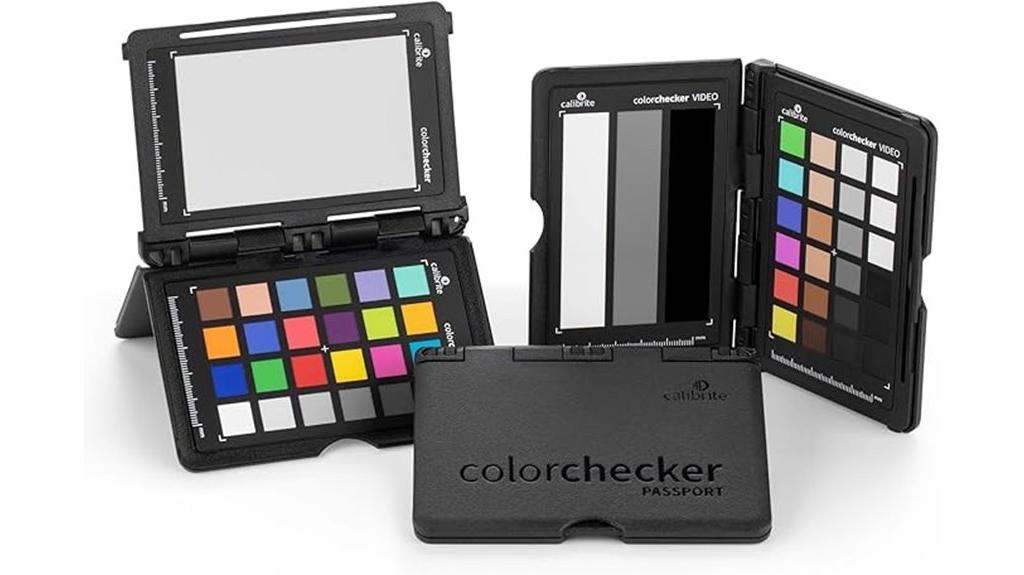
Calibrite ColorChecker Passport Video 2 (CCPPV2) stands out as a must-have for videographers and photographers who need precise color calibration in dynamic lighting conditions. Its portable design includes a 24-patch ColorChecker Classic, a white balance target, and two video targets for flexible use in-camera or during post-production. The software enables custom camera profiles in DNG or ICC formats, ensuring consistent color across multiple devices. Compact and lightweight at just under three ounces, it’s perfect for on-the-go shoots. With a durable case and adjustable stand, the CCPPV2 simplifies scene setup, helping me achieve accurate, repeatable colors regardless of lighting changes or camera changes.
Best For: professional videographers and photographers who require precise, consistent color calibration in dynamic or mixed lighting environments.
Pros:
- Portable and lightweight design for easy on-the-go use
- Includes multiple targets (ColorChecker Classic, white balance, video) for versatile in-camera and post-production calibration
- Software supports creating custom DNG or ICC camera profiles for consistent color matching
Cons:
- Requires a 12V battery, which may need to be purchased separately
- Slightly higher price point compared to basic color calibration tools
- Limited to calibration and profiling; does not include advanced editing features
DKK 5 x 7 Set of 2 White Balance and Color Calibration Charts
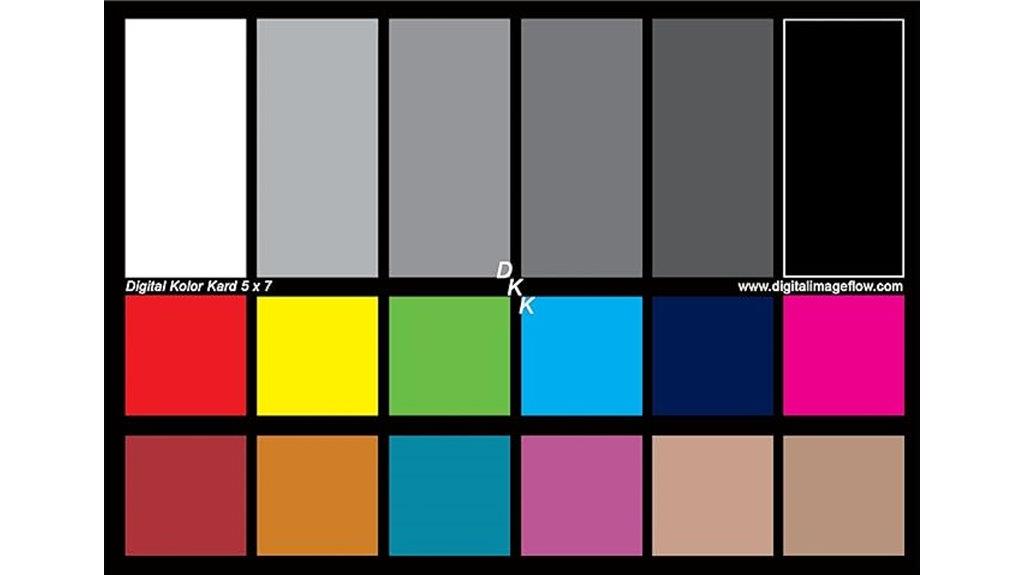
If you’re looking for a reliable tool to guarantee accurate color and white balance in your digital photography, the DKK 5 x 7 Set of 2 White Balance and Color Calibration Charts is an excellent choice. These high-quality, US-made cards feature 18 scientifically designed color patches, including natural tones like skin and foliage, along with multiple neutral gray targets for precise white balance. They also include a 6-step gray scale for exposure calibration. Compact and durable, the set comes with a protective folder and a tabletop stand, making it easy to use in studio or on-location shoots. It’s compatible with popular editing software like Photoshop and Lightroom, ensuring consistent color accuracy from capture to print.
Best For: professional photographers, studio shooters, and digital imaging specialists seeking precise color and white balance calibration tools.
Pros:
- High-quality, US-made construction with durable, archival materials.
- Includes comprehensive color patches, neutral gray targets, and a gray scale for versatile calibration.
- Compact design with protective folder and tabletop stand for easy use in various environments.
Cons:
- Slightly higher price point compared to basic calibration charts.
- May require familiarity with calibration software for optimal results.
- Limited to 2 cards, which might not cover extensive color profiling needs for some professionals.
Professional 18% Gray Camera Color Correction Card (Pack of 2)

The Professional 18% Gray Camera Color Correction Card (Pack of 2) is an essential tool for photographers and videographers who need reliable color balance across multiple devices. Its industry-standard 18% gray reference guarantees accurate white balance and proper exposure settings, helping to eliminate unwanted color casts. The pack includes two professional-grade cards, making it perfect for backup or use with different cameras simultaneously. Compact and portable at 5 x 7 inches, it’s easy to carry for on-location shoots or studio work. This tool guarantees consistent, high-quality results by enabling precise calibration, ensuring your images and videos maintain true-to-life colors.
Best For: professional photographers and videographers who need reliable color calibration across multiple cameras and shooting conditions.
Pros:
- Ensures accurate white balance and exposure with industry-standard 18% gray reference
- Includes two cards for backup or simultaneous use across different devices
- Compact size makes it highly portable for on-location shoots and studio work
Cons:
- May require additional calibration tools for comprehensive color management
- Limited to 18% gray reference; does not include other color targets for broader color correction needs
- Slightly higher cost compared to basic color correction cards without professional-grade features
Pixel Perfect Camera Color Correction Card (2-Pack)

Photographers and videographers who need precise color calibration will find the Pixel Perfect Camera Color Correction Card (2-Pack) to be an essential tool. These 5 x 7-inch cards feature standardized color swatches and neutral gray patches that simplify white balance, exposure, and color accuracy adjustments. Made from durable synthetic paper with a matte finish, they prevent glare and guarantee consistent results across different lighting conditions. The included free Adobe software allows me to create custom profiles for professional-grade calibration. Compact and lightweight, these cards are perfect for on-the-go use, helping me achieve true-to-life colors and polished post-processing results every time.
Best For: photographers and videographers seeking accurate color calibration and professional-grade white balance, exposure, and color correction tools.
Pros:
- Includes two durable, portable 5 x 7-inch cards with standardized color swatches and neutral gray patches
- Compatible with free Adobe DNG profile editor software for custom color calibration
- Made from high-quality synthetic paper with matte finish to prevent glare and ensure consistent results
Cons:
- Customer rating of 3.8 out of 5 stars suggests mixed reviews on effectiveness or value
- Price and availability may vary, and price matching is not guaranteed
- Only includes two cards, which may require additional tools for comprehensive calibration in complex workflows
High Resolution 8.5×11 Chrome SD Professional Lens Test Chart, 3-Pack

For professionals and serious enthusiasts seeking precise lens calibration, the High Resolution 8.5×11 Chrome SD Professional Lens Test Chart, 3-Pack offers all-encompassing testing features in a convenient package. It includes three high-resolution charts suitable for film, digital, and video systems, providing thorough patterns like bars, wedges, zones, and stars for detailed lens testing. The rectilinear grid pattern helps identify barrel and pincushion distortions. Additionally, the chart features accurate color targets, CMYK, and crossed 11-step grayscales for white balance, exposure, and gamma calibration. Printed on durable, high-quality coated paper, these charts ensure clarity and longevity during rigorous testing sessions.
Best For: professional photographers, videographers, and serious enthusiasts who require precise lens calibration and comprehensive testing tools.
Pros:
- Includes three high-resolution charts suitable for film, digital, and video systems.
- Features a variety of patterns and color targets for detailed lens analysis and color calibration.
- Printed on durable, high-quality coated paper ensuring clarity and longevity in rigorous testing environments.
Cons:
- May be more expensive than basic test charts, reflecting its professional-grade features.
- Large size (8.5×11 inches) may require dedicated storage or mounting space.
- Some users might find the extensive pattern options overwhelming for casual or quick testing needs.
Datacolor Spyder Checkr Color Calibration Tool
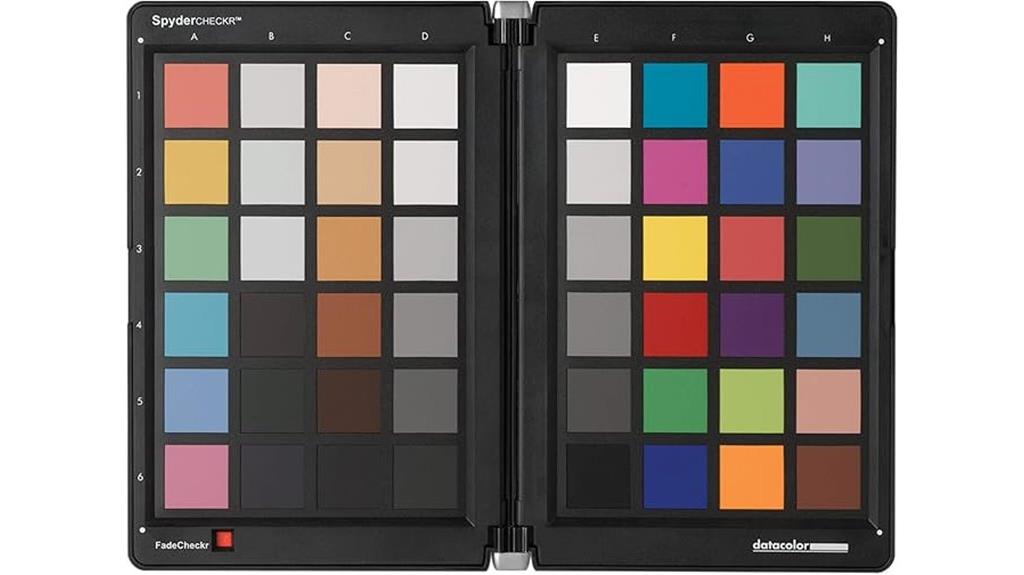
If you need reliable color calibration that works seamlessly across multiple cameras and lighting conditions, the Datacolor Spyder Checkr is an excellent choice. It features 48 spectrally engineered color patches, including sRGB, skin tones, near-whites, and blacks, plus a grey card for precise white balance. The device’s durable design includes a tripod mount and replaceable target cards, ensuring longevity. Its software analyzes test shots to generate HSL presets compatible with Lightroom, Camera RAW, and Hasselblad Phocus, simplifying calibration. With positive reviews and a portable form factor, the Spyder Checkr helps you achieve consistent, accurate colors in your workflow, whether in studio or on location.
Best For: photographers and videographers seeking precise, consistent color calibration across multiple cameras and lighting conditions.
Pros:
- Features 48 spectrally engineered color patches for comprehensive color accuracy.
- Durable, portable design with a tripod mount and replaceable target cards for long-term use.
- Software integration with Lightroom, Camera RAW, and Hasselblad Phocus simplifies calibration workflow.
Cons:
- Initial setup and calibration process may require time for beginners.
- Cost may be higher compared to basic color calibration tools.
- Replacement target cards and fade check patches may incur additional expenses over time.
Datacolor Spyder Checkr Photo for Color Accuracy & Consistency

The Datacolor Spyder Checkr Photo stands out as an ideal choice for those who need reliable and precise color calibration on the go. Its portable, pocket-sized design makes it easy to carry and use in various shooting environments. With 62 color targets—including skin tones, greyscales, and white/black adjustments—it guarantees accurate color reproduction across different lighting conditions. Its compatibility with popular editing software simplifies workflows, automatically creating presets for quick corrections. Recognized by industry awards, it combines affordability, ease of use, and professional-level accuracy, making it a must-have for photographers seeking consistent, high-quality color results in their images.
Best For: photographers and image creators who need portable, accurate color calibration that integrates seamlessly into their workflow.
Pros:
- Compact, pocket-sized design for portability and convenience
- Extensive collection of 62 color targets for versatile color correction
- Compatible with popular editing software to streamline workflows
Cons:
- May require some familiarity with color calibration for optimal use
- Limited to color targets and calibration tools, not a full editing solution
- Slightly higher cost compared to basic color reference charts
Professional Gray Balance Card for Photography & Video (Pack of 2)
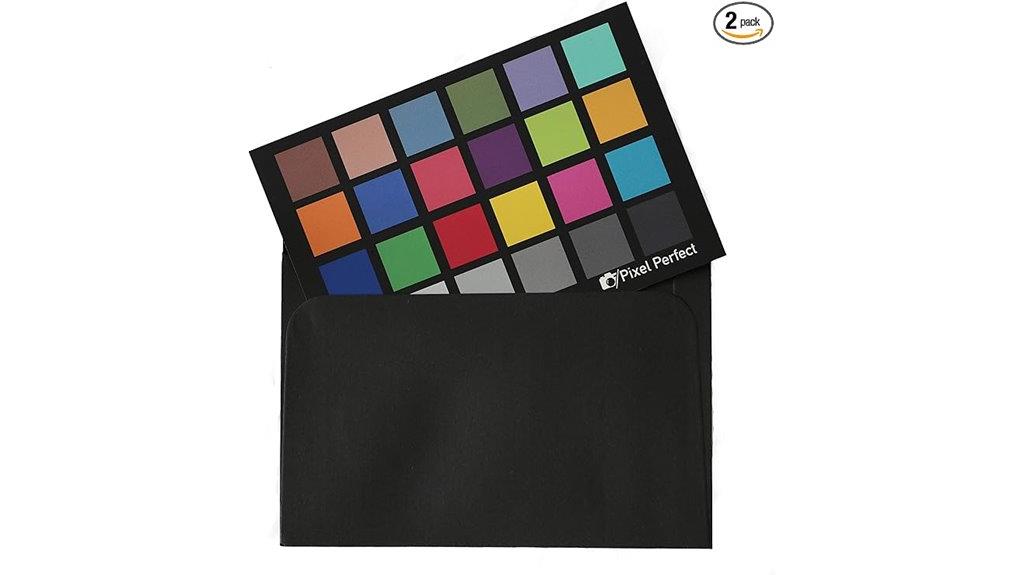
A professional gray balance card is essential for photographers and videographers seeking consistent, accurate color reproduction across their projects. Designed for DSLR, mirrorless, and cinematic cameras, it guarantees precise white balance and exposure calibration with its industry-standard 18% gray reference. The pack includes two high-quality cards, perfect for backups or simultaneous use on multiple cameras. Its compact size (4 x 6 inches) makes it easy to carry in camera bags or pockets, ideal for on-location shoots or studio work. Using these cards helps eliminate color casts, enabling professional-grade results with consistent, true-to-life colors in both photos and videos.
Best For: professional photographers and videographers seeking reliable, accurate color calibration for DSLR, mirrorless, and cinematic cameras during studio or on-location shoots.
Pros:
- Includes two high-quality gray balance cards for backup or multi-camera setups
- Compact 4 x 6-inch size for easy portability and on-the-go use
- Ensures precise white balance and exposure calibration with industry-standard 18% gray reference
Cons:
- May require additional calibration tools for comprehensive color management
- Not designed for use with smartphones or consumer-grade cameras
- Limited to gray balance correction; does not provide color charts for detailed color grading
Calibrite ColorChecker Video (CCVWB)

Calibrite ColorChecker Video (CCVWB) stands out as an essential tool for videographers and colorists seeking precise color calibration on set. Its 8 x 11.5-inch durable plastic design is compatible with most cameras and editing software, making it versatile. The chart features six saturated and six de-saturated color chips, plus four large gray patches for accurate white balance and gray scaling. This allows for consistent, neutral footage and smoother color grading. With positive reviews and a strong market presence, the CCVWB helps ensure professional-quality results, whether you’re filming or post-processing. It’s a reliable, must-have calibration tool for achieving true-to-life color accuracy.
Best For: videographers and colorists seeking precise, professional color calibration for on-set filming and post-production.
Pros:
- Compatible with most video cameras, camcorders, and editing software for versatile use
- Includes a comprehensive set of color and gray patches for accurate white balance and color grading
- Durable plastic construction and compact size make it easy to handle and transport on set
Cons:
- Price may be higher compared to basic calibration charts, potentially limiting accessibility for hobbyists
- Requires proper handling and understanding of color calibration procedures for optimal results
- Limited to video production; not suitable for still photography calibration needs
Factors to Consider When Choosing Photography Color Checker Charts

When choosing a photography color checker chart, I focus on color accuracy standards to guarantee true-to-life results. I also consider compatibility with my devices and calibration software to keep everything seamless. Ultimately, I weigh factors like durability, portability, and size to match my shooting needs.
Color Accuracy Standards
Choosing a photography color checker chart hinges on understanding the color accuracy standards it guarantees, which assure consistent color reproduction across different devices and workflows. High-quality charts are based on standardized color spaces like sRGB, Adobe RGB, or Rec. 709, providing reliable benchmarks for calibration. They use spectrally formulated pigment patches to match real-world colors accurately, reducing discrepancies during color management. Including neutral gray patches, such as 18% gray, is vital for proper white balance and exposure calibration, aligning with industry norms. Additionally, durable, fade-resistant inks and stable materials help maintain calibration integrity over time. Finally, compliance with industry standards like ISO or ANSI ensures the chart’s suitability for professional workflows, guaranteeing precision and consistency in color fidelity.
Compatibility With Devices
Selecting a color checker chart that’s compatible with your devices is essential for effective calibration. First, ensure the chart suits your camera type—whether you’re shooting with DSLR, mirrorless, or video cameras—so it aligns with your workflow. Check if the size and design fit your shooting environment, whether in the studio, on location, or during post-processing. Compatibility with your editing software, like Lightroom, Photoshop, or video platforms, helps streamline calibration without hassle. It’s also important that the color patches and gray scales are spectrally formulated or follow industry standards for accurate color reproduction. Finally, verify that the chart supports your device’s output formats and calibration workflows, ensuring the chart integrates seamlessly and maximizes your color accuracy efforts across all your equipment.
Material Durability
Durability is a crucial factor when picking a photography color checker chart, as it directly impacts how well the chart holds up over time. A well-made chart resists warping, tearing, and fading despite frequent handling, transport, and environmental exposure. I recommend choosing charts made from high-quality synthetic papers or laminated surfaces, as these materials are resistant to moisture, scratches, and UV damage, ensuring calibration accuracy remains consistent. Reinforced edges and sturdy construction prevent bending or creasing, which can distort the color patches and compromise results. Investing in durable materials not only extends the chart’s lifespan but also guarantees reliable performance across multiple shoots. This way, your color calibration stays precise, saving you time and money in the long run.
Calibration Software Support
When evaluating a photography color checker chart, it’s important to contemplate how well it integrates with your editing workflow through compatible calibration software. Make sure the chart comes with or supports software like Adobe DNG Profile Editor or Lightroom presets for smooth integration. These tools allow you to create custom camera profiles, adjust white balance, and fine-tune exposure based on the chart’s target patches, ensuring accurate color reproduction. Check if the software offers both automatic and manual calibration options to give you flexibility in correction precision. Additionally, verify that the software is regularly updated and compatible with your operating system and editing programs. Good instructions, tutorials, and user guides are also valuable, helping you maximize the chart’s potential in your calibration process.
Portability and Size
Choosing the right size and portability of a color checker chart can make a big difference during on-location shoots. Smaller charts, around 4 x 6 inches, are lightweight and easy to slip into camera bags or pockets, making setup quick and hassle-free. Compact designs made of synthetic paper or plastic are durable yet lightweight, ensuring they can withstand outdoor conditions without adding bulk. Foldable or flexible charts are great options—they offer a larger color reference area while remaining portable. Adding protective cases or stands can further improve handling and convenience in diverse environments. When selecting, I balance size and weight with the need for enough color patches and detail to guarantee accurate calibration. The goal is a chart that’s both practical to carry and effective for color accuracy.
Price and Value
Evaluating the price and value of a photography color checker chart involves balancing cost against its professional features and accuracy. I look at whether the chart includes spectrally formulated pigment patches and neutral gray targets, which improve calibration precision without extra expense. I also consider if it offers software support or calibration tools that enhance workflow efficiency, justifying a higher price. Customer reviews help me gauge if the product delivers consistent quality and reliability relative to its cost. Durability and portability are also key; charts made from high-quality materials and designed compactly tend to last longer and are easier to carry around. Ultimately, I want a chart that provides accurate, reliable results without overspending on unnecessary features.
Frequently Asked Questions
How Do I Choose the Right Size of Color Checker Chart?
I recommend choosing a size that fits comfortably in your camera bag or kit, so it’s easy to carry and use on location. Smaller charts, like 8×10 inches, are lightweight and portable, perfect for quick shoots. Larger ones, like 11×14 inches, offer more detail for studio work but can be bulky. Consider your shooting environment and storage space to pick the ideal size that balances convenience and accuracy.
Are There Specific Charts Recommended for Different Camera Brands?
Yes, I recommend specific charts for different camera brands, especially if you’re shooting in a studio setting. For example, X-Rite’s ColorChecker Passport Photo is great for DSLR and mirrorless cameras, offering a compact, versatile option. If you’re working with medium format or high-end cameras, consider larger charts like the X-Rite ColorChecker Classic for better accuracy. Always choose a chart compatible with your camera’s sensor and workflow to guarantee the best results.
How Often Should I Calibrate My Color Checker Charts?
I recommend calibrating your color checker charts every few months or whenever you notice color shifts in your photos. Regular calibration guarantees consistent color accuracy, especially if you frequently change lighting conditions or shoot different projects. I personally keep a schedule and calibrate after any major setup change or gear update. Staying proactive helps me trust my color work and achieve accurate, professional results every time.
Can Color Checker Charts Be Used for Drone Photography?
Absolutely, color checker charts are like a secret sauce for drone photography! I use them to make certain my aerial shots capture true-to-life colors, especially when lighting conditions are tricky. Just like a painter needs the right palette, I rely on these charts to keep my colors consistent and accurate. They’re a game-changer for professional results, giving my drone footage that polished, vibrant look every time.
Do All Charts Work Equally Well for Both Photography and Videography?
Not all charts work equally well for both photography and videography. I’ve found that some charts are optimized for still images, offering better color swatches and more detailed calibration. Others are designed specifically for video, with features like larger swatches or different color spaces. If you want the best results, choose a chart tailored to your primary use, ensuring accurate color reproduction whether you’re shooting photos or capturing footage.
Conclusion
Choosing the right color checker chart can truly transform your photography, making perfect color accuracy feel like second nature. With the right tool, you’ll elevate your images from good to mind-blowingly stunning—almost like magic! Remember, investing in a quality chart isn’t just a purchase; it’s your secret weapon for consistently professional results. So go ahead, pick the perfect one and watch your photos shine brighter than ever before!
